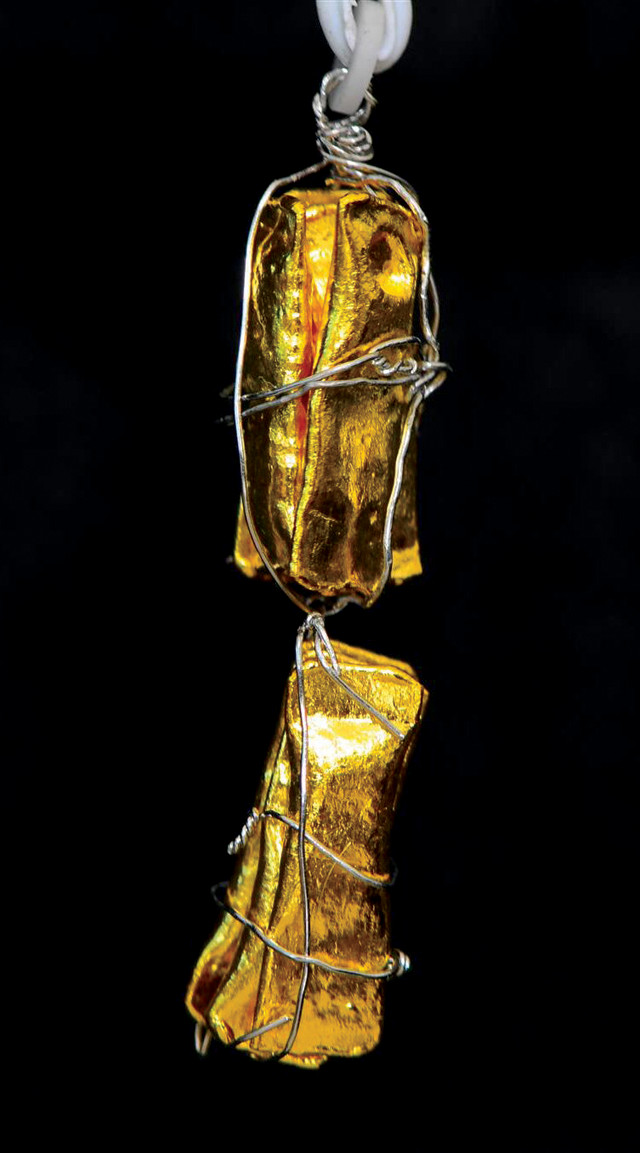
by Adityarup "Rup" Chakravorty Tuesday, July 3, 2018

To replicate conditions inside magma chambers, samples were encapsulated in gold foil and subjected to temperatures up to 1,040 degrees Celsius and pressures up to a thousand times atmospheric pressure. Credit: ©Lennart A. Fischer.
Most iron ore comes from sedimentary deposits. However, a sizeable minority is mined from volcanic rocks, including those found along the Coastal Cordillera of northern Chile, and in Kiruna, Sweden.
The origin of these so-called “Kiruna-type” deposits is controversial, but a recent laboratory study, published in Nature Communications, suggests that some of these iron ore deposits could have formed from magma through the separation of immiscible liquids — some containing iron and some not — as the molten rock cooled.
There are three commonly proposed hypotheses for how Kiruna-type deposits form: separation of iron-rich melt from silica-rich melt in magma chambers, replacement of volcanic rocks with iron-rich minerals via hydrothermal fluids, and flotation of magnetite from a silicate magma. Each process involves unanswered questions.
“One of the main issues with the magmatic origin hypothesis is the lack of silicon in the ore bodies,” says Olivier Namur, a geologist at the University of Leuven in Belgium, and a co-author of the new study. “All magma on Earth contains a lot of silica, and it is not clear how silica-free ore bodies could be produced from such magmas.”
Namur and his colleagues tackled these questions by performing experiments under realistic pressures and temperatures. “Most previous experiments were conducted at standard atmospheric pressures that required very high temperatures, higher than what would occur naturally,” says Adam Simon, a geologist at the University of Michigan who was not involved in the study.
To replicate conditions inside magma chambers, researchers encapsulated samples of raw materials — such as silicon and metal oxides and carbonates, calcium phosphate and fluoride, and in some cases, water and iron sulfide — in gold foil and placed them in a furnace, then raised the temperature to 1,000 to 1,040 degrees Celsius and the pressure to about 1,000 times the atmospheric pressure at Earth’s surface.
Under these conditions, the molten material split into two immiscible liquids. One of the liquids contained most of the silica, whereas the other was extremely rich in iron — up to 40 percent iron — and phosphorus. “Importantly, the iron-rich melts contained almost no silica, and therefore have the right composition to form [Kiruna-type] ore bodies,” Namur says. “We demonstrate for the first time that magmas can crystallize into Kiruna-type deposits and that hydrothermal fluids are not needed in the process.”
The study also showed that high water content and fluoride levels, as well as the oxidation state of magma, can increase liquid immiscibility and the separation of the iron-rich and silica-rich fractions. “High water concentrations are observed in many subduction-related volcanoes, and high concentrations of fluorine are also relatively common,” Namur says. “We also think that magmas must become more oxidized than typical subduction-related magmas in order to … form Kiruna-type deposits.”
While the study adds to the discussion on the formation of some Kiruna-type deposits, the experimental results have yet to be reconciled with field and ore-texture observations, says Fernando Barra, a geologist at the University of Chile who was not involved in the study.
“For example, one of the main conclusions of the study is that the silica-rich melt forms the host rocks for the Kiruna-type deposits,” Barra says. “But none of the more than 50 such deposits in the Coastal Cordillera of northern Chile are hosted in similar rocks.”
Simon says that while the study is the first to show that liquid immiscibility is possible under naturally occurring conditions, many questions remain unanswered. For instance, “the experiments required 20 to 40 percent phosphorus by weight [in the starting magma] to produce the iron-rich, phosphorus-rich liquid,” Simon says. “But natural deposits often contain much less apatite — a mineral rich in phosphorus. There is far too much phosphorus in the laboratory iron-rich melt compared to many Kiruna-type deposits.”
Namur acknowledges that “it might be more complicated to explain the formation of apatite-free or apatite-poor Kiruna-type deposits because all the silica-poor, iron-rich melt in our study contains quite a lot of phosphorus.” However, he says that other processes could contribute to form low phosphorus deposits. “These could include degassing of phosphorus-bearing fluids during magma decompression, or crystal segregation from a phosphorus-poor iron-rich immiscible melt, for instance,” he says.
Simon says there is also a growing consensus that iron ore deposits that are rich in apatite are tied to iron ore deposits also rich in copper and gold. “Any model that explains one also needs to explain the other,” he says. “But as far as I am aware, no study has yet performed a laboratory experiment that can produce both iron-oxide-apatite and iron-oxide-copper-gold fractions.”
A better understanding of how Kiruna-type deposits form has geological and commercial implications. These deposits contain large amounts of iron ore, but can also be rich in other metals, such as copper, gold, silver and uranium. “The absence of an agreed-upon model as to how these deposits form actually hinders our ability to search for other deposits,” Simon says.
© 2008-2021. All rights reserved. Any copying, redistribution or retransmission of any of the contents of this service without the expressed written permission of the American Geosciences Institute is expressly prohibited. Click here for all copyright requests.